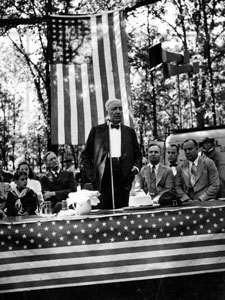Frank O. Lowden

Frank Lowden was born on January 26, 1861, in Sunrise City, Minnesota. He grew up on a farm and as a young boy he worked on the farm and attended a Quaker academy in New Providence, Iowa. For five years thereafter he taught in
small-town and rural schools. Lowden then attended the University of Iowa and was the class valedictorian at Union College of Law (now Northwestern University School of Law). In 1887 he was admitted to law practice in Illinois and
for many years was a very successful lawyer.
In 1894 Lowden met Florence Pullman and married her on April 29, 1896. On January 20, 1897, Lowdens first child, George M. Pullman Lowden, was born. One fall night Lowden said to his wife, "I am beginning to look at a
summer home near Chicago, where it is just as good for you and the baby or babies as at the seashore, with a good deal of favor."
On May 4, 1898, Florence Lowden was born. Florences mother kept a diary, and on May 15, 1899, she wrote, "Frank and I have been on a farm hunting expedition. We went to Oregon, Illinois, to look at a very beautiful farm of 600
acres on the Rock River. We were most pleased and made an offer."
Mrs. Lowden purchased the house and the land on May 20, 1899. The 576 acres and house cost $27,500. Over the years, Lowden bought thousands more acres, up to about 4,400 acres. Daughter Harriet was born on August 7, 1900, shortly
after they moved to "The Oaks." In 1902 Mrs. Lowden changed the name of the property to Sinnissippi Farm, the Indian name for the Rock River, meaning rocky waters. Reforestation was started by Mr. Lowden around 1902 and was continued
until our entry into World War I.
In 1906 Lowden was elected to the United States Congress. He did not count on politics for his future and was more dependent on his success as a lawyer. Lowden retired from Congress in 1910.
Lowden aimed for increased political responsibility. In 1916 he was elected governor of Illinois. Lowden also wanted to make sure that the government was run honestly and fairly, and he wanted a new constitution that would centralize
tax structure and permit an income tax [note: Lowdens hope for an income tax was not granted until 1969.]. He gained wide notice as governor by his reorganization of the state government and by his effective handling of the Chicago
race riots in 1919.
In 1920 Lowden was an unsuccessful candidate for president at the Republican convention. Lowden served out his gubernatorial term until 1921 and was nominated for vice president in 1924. Thereafter he retired to Sinnissippi Farms to
spend more time with his family and take care of his land.
Governor Lowden was the proud holder of the Silver Buffalo, Scoutings highest award given to adults for leadership. Governor Lowden served as a lifetime member of the National Rural Scout Committee.
In 1938 Mr. Lowden entered into an agreement with the University of Illinois Department of Forestry to supervise the management of his woodlands in return for permission to carry out research studies on the forest. In October 1955
Sinnissippi Forest became the first Illinois Tree Farm.
Mrs. Lowden died in 1937 and Frank Lowden later moved to Tucson, Arizona, where he died of cancer on March 20, 1943. He is buried in Chicago.
In 1964 Northern Illinois University in DeKalb built Frank O. Lowden Hall, which houses many offices for the university.
In addition, his portrait hangs in the state capitol building in Springfield along with all other Illinois governors.
On October 7, 1993, Phillip Lowden Miller and his wife, Bonnie, sold 1,039 acres of the Lowden-Miller estate, Sinnissippi Forest, to the State of Illinois. At the formal dedication of Sinnissippi Forest as a state site in 1993,
Phillip Miller said, "We are delighted that the tradition of proper land use started by Governor Lowden on this property is continuing with others." Lowden once said,
I like to think of that beautiful and fertile spot as a place where my children and my childrens children and their children after them will gather long after I have become dust.
These are fitting words for one of Governor Lowdens chief public legacies.
Due to the death of Governor Lowden, 1943 was designated as the "Lowden Memorial Year."



|
